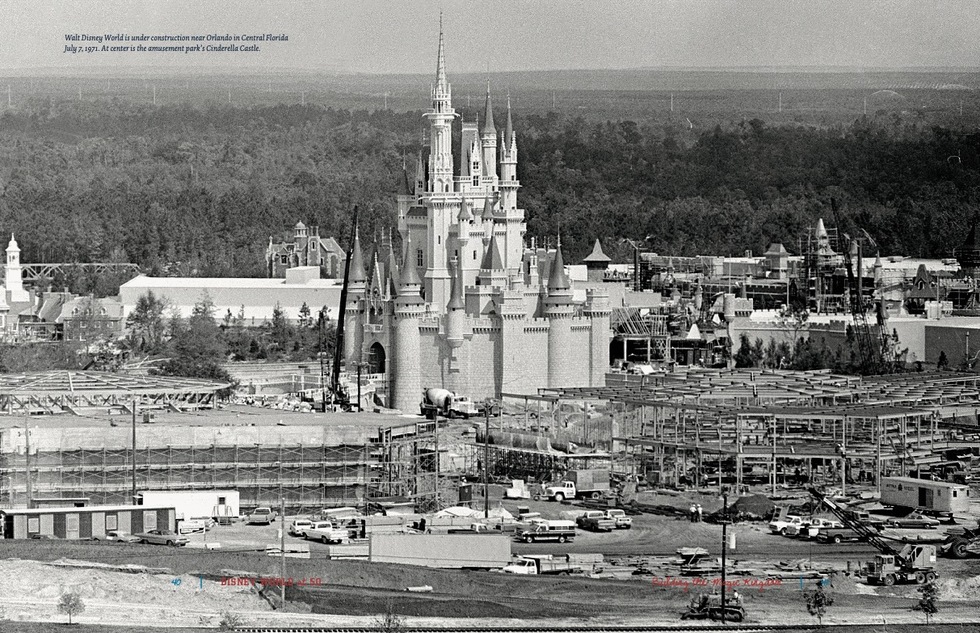In 1964, Walt Disney began secretly buying millions of dollars worth of Central Florida farmland. As vast areas of land were purchased in lots of 5,000 acres here, 20,000 there -- at remarkably high prices -- rumors flew as to who needed so much land and had the money to acquire it. Some thought it was Howard Hughes; others, the space program. Speculation was rife almost to the very day, November 15, 1965 ("D" Day for Orlando), when Uncle Walt arrived in town and announced his plans to build the world's most spectacular theme park ("bigger and better than Disneyland"). In a 2-year construction effort, Disney employed 9,000 people. Land speculation reached unprecedented heights, as hotel chains and restaurateurs grabbed up property near the proposed park. Mere swampland sold for millions. The total cost of the project by its October 1971 opening was $400 million. Mickey Mouse escorted the first visitor into the Magic Kingdom, and numerous celebrities, from Bob Hope to Julie Andrews, took part in the opening ceremonies. In Walt Disney World's first 2 years, the attraction drew 20 million visitors and employed 13,000 people. The sleepy citrus-growing town of Orlando had become the "Action Center of Florida," and the fastest-growing city in the state.
Additional attractions multiplied faster than fruit flies, and hundreds of firms relocated their businesses to the area. SeaWorld, a major theme park, came to town in 1973. All the while, Walt Disney World continued to grow and expand, adding Epcot in 1982 and Disney-MGM Studios (now Disney's Hollywood Studios) in 1989, along with water parks; more than a dozen "official" resorts; a shopping, dining, and entertainment district; campgrounds; a vast array of recreational facilities; and several other adjuncts. In 1998, Disney opened yet another theme park, this one dedicated to zoological entertainment and aptly called Animal Kingdom.
Universal Orlando, whose Universal Studios Florida park opened in 1990, continued to expand and keep the stakes high. In late 1998, it unveiled a new entertainment district, CityWalk, and in 1999, it opened Islands of Adventure, a second theme park including attractions dedicated to Dr. Seuss, Marvel Comics, and Jurassic Park. By 2017, it had added a lush new water slide park, Volcano Bay, and between 1999 and 2020, it opened eight giant hotels to serve its resort.
SeaWorld, too, got in on the action when it opened its $100-million sister park, Discovery Cove, in 2000, and a water slide park, Aquatica, in 2008. SeaWorld also began a long transition from being known as a wildlife park to one known more for thrilling rides, and it now hosts Orlando's largest and fastest roller coasters.
At the theme parks, the extreme building frenzy of the 1990s simmered down after 1999, and the corporations that own them began to focus mostly on building new areas within the parks. Universal took the most leaps in tha area, adding the first Wizarding World of Harry Potter at Islands of Adventure in 2010, and then linking it with a second Harry Potter world at the Studios a few years later. The additions elevated Universal to a place where attendance was neck-and-neck with some of Disney's Orlando parks.
Disney expanded and reorganized Fantasyland in 2012, added an Avatar-themed land to Animal Kingdom in 2017, and then opened a Star Wars-themed land to Hollywood Studios (and Disneyland) just before the Covid-19 pandemic closed the resorts for multiple months in 2020.
Universal is now building a third major theme park, Epic Universe, a few miles from its original campus. That's slated to open in 2025.
Note: This information was accurate when it was published, but can change without notice. Please be sure to confirm all rates and details directly with the companies in question before planning your trip.









